Decimalisation in Britain
Until Monday 15 February 1971, the United Kingdom of Great Britain and Northern Ireland (UK) used pounds, shillings and pence. On that day both the UK and the Republic of Ireland switched to a new system with 100 pence in the pound and no shillings.
Britain was not the last country to use pounds, shillings and pence. The Gambia, Malta and Nigeria still used pounds, shillings and pence after the UK switched to decimal currency. All three changed soon after.
Traditionalists see the pounds, shillings and pence system as British. But a Frenchman, Pepin the Short, King of the Francs invented it. Britain and British Commonwealth countries were the last to use the system.
Britain's new coins

New Halfpenny
½p
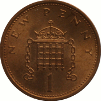
One New Penny
1p
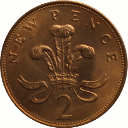
Two New Pence
2p
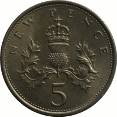
Five New Pence
5p
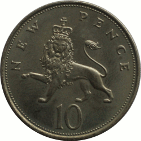
Ten New Pence
10p
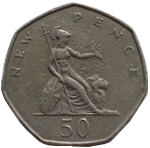
Fifty New Pence
50p
The new decimal coins are shown above. This side is called the reverse. Christopher Ironside, who designed coins for other countries, designed the reverse of the new coins.
The side with the Queen's head on is called the obverse. There was a new portrait of the Queen on the obverse. It was a similar portrait to that used on UK definitive stamps (the ordinary ones). This design was by Arnold Machin.
Britain's path to decimalisation
Most of Europe's currencies were derived from the system introduced by Pepin the Short in France AD 755. (For more information see Origins of pounds, shillings and pence.
The first country to use decimal currency was Russia. As far back as 1535 one ruble was worth 100 denga. Peter the Great established the system of 1 ruble = 100 kopeks in 1704.
The next country to introduce decimal currency was the USA. America's founding fathers introduced the US dollar worth 100 cents.
France introduced decimal currency in 1795 following the French Revolution. France under Napoleon was instrumental in spreading decimal currency in Europe. The following countries had adopted decimal currency by the early twentieth century.
- 1535 - Russia - Novgorod ruble worth 100 denga
- 1704 - Russia - ruble worth 100 kopeks
- 1795 - France - franc worth 100 centimes
- 1798 - Switzerland - franc worth 100 centimes
- 1817 - The Netherlands - guilder worth 100 cents
- 1832 - Belgium - franc worth 100 centimes
- 1832 - Greece - drachma worth 100 lepta
- 1844 - Turkey - (Ottoman)lira worth 100 kurus
- 1854 - Luxembourg - franc worth 100 centimes
- 1858 - Canada - dollar worth 100 cents
- 1860 - Finland - markka worth 100 penni
- 1861 - Italy - lira worth 100 centesimo
- 1867 - Romania - lei worth 100 bani (singular ban)
- 1868 - Spain - pesata worth 100 céntimos
- 1871 - Germany - mark worth 100 pfennig
- 1876 - Sweden/Denmark/Norway - krona/krone worth 100 öre
- 1881 - Bulgaria - lev worth 100 stotinka
- 1911 - Portugal - escudo worth 100 centavos
- 1917 - Poland - marka worth 100 fenigs
- 1918 - Yugoslavia - dinar worth 100 para
- 1918 - Czechoslovakia - koruna worth 100 halér
- 1924 - Poland - zloty worth 100 grosz
- 1924 - Austria - schilling worth 100 groschen
- 1926 - Albania - lek worth 100 qindar
Charles Babbage was famous for making the Difference Engine, an early mechanical computer. He argued that Britain should adopt decimal currency in his book of 1832, 'The Economy of Manufactures'. Babbage recommended a system based on dividing the pound into 1000 units. In 1832 one pound was worth £78 today. There were 960 farthings in the pound. So Babbage's system did not seem too big a change. Cyprus adopted Babbage's system in 1955.
Decimal currency had its advocates in Parliament as well as in the fields of mathematics and finance. There were no less than four Royal Commissions on decimal currency in 1838, 1846, 1856 and 1918.

The first two Commissions recommended decimal currency. The Royal Mint minted Britain's first decimal coin in 1849 - the two shilling piece or florin, which carried the phrase 'one tenth of a pound'.
The florin was withdrawn from circulation in 1993. It was Britain's first decimal coin and the last coin from the old system to be legal tender.
The other two Royal Commissions decided against decimal currency. In all cases they thought it was a good idea, but weighed this against the costs of conversion.
Britain introduced decimal currency in 1907, not for the UK, but for some states in British controlled Africa. From 1907 present day Uganda and Kenya used a rupee worth 100 cents. In 1921 Britian introduced the East African shilling into Kenya and Tanganyika (Tanzania). The East African shilling had the same value as a UK shilling, one twentieth of a pound sterling, but was divided into 100 cents. Kenya, Uganda and Tanzania use the shilling as their currency today.
The question of decimalisation for the UK was then put on hold until after the Second World War.
Pressure for decimalisation grows
Decimal currency was easier to understand and easier to do calculations with. This had been the case in the nineteenth century.
Decimal currency was also easier for computers to process rather than pounds, shillings and pence. Yet the cost of converting to decimal was still considered huge. Though pressure to make the change got a new urgency in the early 1960s.
Britain was losing trade because people from other countries did not understand our money. Britain wanted to join the Common Market and all of Europe was decimalised. Some of the advantages of the new trading opportunities would be lost.
Britain's trading partners in the Commonwealth were also converting to decimal. Canada had decimal currency since 1858 and Ceylon (Sri Lanka) since 1869. More recently Cyprus, which used the Cypriot pound, changed to a system of 1000 mils to the pound in 1955. In 1957 India also changed to decimal currency. India's old currency was 16 annas to the rupee and 12 pies to the anna. From 1957 it was 100 paise (singular paisa) to the rupee.
South Africa was due to decimalise in 1961. Australia and New Zealand already had plans for decimalisation. There was a fear that by 1965 Britain might be the only country left using £sd.
Halsbury Committee
In 1961 the Government decided in favour of decimal currency. It was no longer of question of if, but when, how and how much?
South Africa's system replaced the pound with the rand, worth 100 cents. But with a key difference, a rand was worth 10 shillings not a pound.
A particular problem to the UK was the high value of the pound. If the pound was divided into 100 cents, the value of one cent, 2.4d might by too high. This seems ludicrous today, but in 1960 100th of a pound was worth 16p. In 1960 the smallest coin, the halfpenny, was worth only 3p. Pundits thought a half cent was needed. Purists argued that this was not pure decimal and might pose problems for banking and computer systems.
Two other possibilities were to base the system on the crown (5 shillings) divided into 100 cents or to make a pound worth 100d.
At the end of 1961, the Chancellor of the Exchequer, Selwyn Lloyd, set up the Committee of Inquiry on Decimal Currency under Earl of Halsbury to look at how Britain could adopt decimal currency.
In 1963, the Halsbury Committee issued its report. The report had a huge influence on the system Britain adopted and how it went about it.
The Committee's recommendation was for a new currency based on the pound sterling, not the 10 shillings = 100 cents system. [2]
They did not give a name for the minor unit, but suggested either 'cents' or 'decimal pennies'. Their suggestion was for 3 new bronze coins worth ½cent, 1 cent and 2 cents and a new cupronickel (silver colour) 20 cent piece. The original 1 shilling and 2 shilling coins would stay, to be replaced by 5 and 10 cent pieces. They thought that the 20 cent piece might be too large a denomination and unpopular. The 20 cent piece was the only part of the recommendation not adopted. [2]
The verdict was not unanimous. A minority, Mr V N Ely and Mr J M A Smith, wanted the South African system of 10 shillings as the main unit. The advantage of this system is that it would be pure decimal. There were no fractions needed. They would also be able to keep the sixpence (worth 5 cents) and the half crown (worth 25 cents) as well as the shilling (worth 10 cents) and florin (worth 20 cents). [2]
Those proposing to keep the pound argued that it would not make economic sense to half its value. In the 1960s sterling was still used as a reserve currency. Halving the value of the pound might make sterling lose prestige in international currency markets.
Another system the Committee considered was keeping the old penny and having a pound worth 100d or 8s 4d. But they thought that this system would be more difficult for people to get used to and the silver coins worth 6, 12, 24 and 30 pence would need to be replaced.
Testing showed that the 10 shillings = 100 cents system might be easier for people to get used to.
The Committee proposed that the changeover should be in February. The banks and retailers would need a long weekend to get ready. So D-Day (the name that the Committee suggested) would be a Monday or a Tuesday. They also suggested a two year transition period.
The Committee gave a final warning. Rounding up prices after decimalisation in either system might lead to inflation.
Decimalisation gets the green light
Between the Halsbury Committee reporting and further progress on decimalisation there was a change of government. The incoming Labour Government, under Harold Wilson, continued with the existing plans.
On 1 March 1966, the Chancellor of the Exchequer, James Callaghan, announced the Government's decision to adopt decimal currency in February 1971. According to Dominic Sandbrook, Callaghan mentioned including decimal currency in his 1966 budget. Prime Minister Harold Wilson said 'Why not?'. [3]
They adopted the Halsbury Committee's recommendations almost completely. Two further Commonwealth countries followed South Africa's lead and swapped the pound for a 100 cent system based on a main unit worth 10 shillings. Both Australia in 1966 and New Zealand in 1967 adopted the dollar with an exchange value of 10 shillings. There was passionate argument inside the UK for this system. Retailers in particular thought that it would be easier to switch.
The Government held firm and stuck to a system based on one pound sterling as the main unit. At the end of 1966 the Government set up the Decimal Currency Board, under Lord Fiske, to oversee Britain's transition to decimal. Fiske was leader of the Greater London Council, but had worked for the Bank of England.
Count down to D-Day
Once the decision was made there was a huge amount of preparation needed. New coins needed to be designed and minted. Cash registers needed to be replaced or updated. Telephone boxes and parking meters needed to take the new money.
The new coins got a new obverse (the Queen's portrait) and reverse, what most people think of as the front of the coin.
The design for the obverse had already been done. In June 1964, the Queen approved a new design by Arnold Machin for use on UK and Commonwealth coins. It was similar to another Machin portrait used in the UK on the new issue of definitive stamps in 1967.

Machin's portrait was first used on coins in 1964, not in the UK, but in Southern Rhodesia (now Zimbabwe). Rhodesia needed new coins because the Federation of Rhodesia and Nyasaland dissolved in 1963. The Federation comprised Southern Rhodesia, Northern Rhodesia and Nyasaland. The latter two countries gained independence as Zambia and Malawi respectively. Southern Rhodesia remained under British rule, but illegally declared independence under Prime Minister Ian Smith in 1965.
The new coins issued by Rhodesia were a strange mix of decimal and non-decimal. The unit of currency was still the pound but new coins were issued denominated in both cents and pounds.
- six pence / 5 cents
- 1 shilling / 10 cents
- 2 shilling / 20 cents
- half a crown / 25 cents
The Rhodesian 10 shillings was worth 100 cents. The new coins issued by Rhodesia were compatible with the South African rand.
The other two independent African nations issued their own coins, but continued with pounds, shillings and pence. Residents of the three countries had been able to use the same money in all three. Now, although coins were the same size, weight and value, they were not interchangeable. According to one Rhodesian, to offer a porter in one country another's coin as a tip was taken as an insult. [4]
Australia in 1966 and New Zealand in 1967 both used the Machin portrait on their new decimal coins.

Britain's first decimal coins
The first UK coins bearing the Machin portrait were the new five and ten pence pieces issued in 1968. The reverse of these coins and all the decimal coins were designed by Christopher Ironside.
The Royal Mint made the design of all of the coins, except the 50 pence, public in 1968. Mr J H James, the Deputy Master of the Royal Mint said he thought that there would be regret over Britannia's disappearance. He also explained that large numbers were needed on the coins to help people understand the new system.
All of the designs had the words 'new pence' or 'new penny' and a large number indicating the value. The designs were as follows:
- ½ new penny the crown of St Edward the Confessor
- 1 new penny - a portcullis and crown (following the design of the threepenny bit
- 2 new pence - the Prince of Wales' plumes
- 5 new pence - a Scottish thistle and crown (this replaced the tradition of issuing an English and a Scottish shilling)
- 10 new pence - a crowned lion
From mid-1968 the Royal Mint also offered 'Britain's first decimal coins' for sale in a plastic wallet. The 5p and 10p were dated 1968. The ½p, 1p and 2p were dated 1971. The 5p and 10p were legal tender, the bronze coins were not.
Britannia reappeared a year later when the new 50 pence piece was issued.
Both the 50p and the new halfpenny caused controversy. The halfpenny was worth more than the outgoing 1d. In today's money it would have been worth 6p. But people were not keen on small coins. The farthing and the silver 3d had already gone. In the 1930s people refused the silver 3d in their change. In the 1950s they refused the farthing. Would the new halfpenny have the same fate?
The 50p got the nickname 'ten-bob bit'. It was worth 10 shillings when introduced in 1969. In today's money it would have been nearer £6. But it was similar size to the 10p. Some pensioners found it difficult to tell the difference. People doing busy jobs, such as bus conductors and ticket clerks, also complained. Some went as far as refusing the new 50p. To help smooth the waters the Bank of England kept the 10 shilling note valid for another year.
Britain's path to decimalisation had already started in 1968 when the new five and ten pence coins were issued. These are the events leading up to D-Day.
- 1968 - 4 February - the date of 15 February 1971, confirmed for D-Day (Decimal Day)
- 1968 - Tuesday 16 April 1968 decimal coins for five and ten new pence issued. They were identical in size, weight and value to the existing one shilling and two shilling pieces.
- 1969 - 1 August - the old halfpenny coin was withdrawn
- 1969 - Monday 13 October - The Bank of England ceased issuing 10 shilling notes
- 1969 - Tuesday 14 October - decimal 50p issued.
- 1970 - 1 January half crown withdrawn. The old coins were melted down to make the new decimal cupronickel coins.
- 1970 - Wednesday 17 June 1970 - The Post Office issued the first decimal stamps: 10p (Cerise), 20p (Olive green) 50p (Blue). These were the large 'high value stamps'. All could be bought with old money coins: 2/-, 4/- and 10/- respectively. The stamps for £1 and upwards were, like the banknotes, unchanged by decimalisation.
- 1970 - 22 November - Ten Shilling called by the Bank of England. (No longer legal tender but could be exchanged)[5]
- 1970 - 11 December - The BBC starts a series of radio broadcasts for retailers called 'Decimal Points'
- 1971 - Thursday, 11 February - the banks closed for four days. They re-opened on D-Day ready for banking in decimal
- 1971 - Monday 15 February - D-Day. Low value (1/2, 1p, 2p) coins become legal tender. Decimalisation is official.
- 1971 - 31 August - transition period ends
- 1971 - 1 September penny and threepenny bit withdrawn
National Cash Register (NCR) took out a number of press adverts advising retailers to contact them for help with converting to decimal. Read more about Getting ready for Decimalisation
Also in the run up to decimalisation a number of decimal toys and games appeared to help people understand the new money. There was also a decimalisation tea towel.
Britain's first decimal stamps

Reproduced by kind permission of Royal Mail Group Ltd
On 17 June 1970 the Post Office issued Britain's first decimal stamps. These were the high value definitives. The Post Office issued these stamps ahead of D-Day to help with printing and distribution. They could issue these stamps because it was possible to buy them with old money. Their values were 2/-, 4/- and 10/-. People could also buy them with the new 5p, 10p and 50p coins.
The colours were cerise (10p), olive green (20p) and blue (50p). The blue was the same colour as the 10 shilling stamp issued in 1969. There could be no confusion because the values were the same.
D-Day
On Monday 15 February 1971 people's shopping experience was changed forever. They could see prices in decimal. They would get change in the new ½p, 1p and 2p. The 5p, 10p and 50p were already in circulation.
On the same day, the Republic of Ireland also changed to decimal currency as did the Isle of Man, Jersey, Guernsey and Malawi. Only Malta, the Gambia and Nigeria were using pounds, shillings and pence. The Bank of Malta declared that the new British ½p, 1p and 2p coins would not be legal tender on Malta.
The Gambia converted to decimal later in 1971 and Malta in 1972. Nigeria was the last stronghold of the old British currency. Nigeria decimalised in 1973.
On the 15 February 1971 the Post office issued the second set of definitive stamps.

Reproduced by kind permission of Royal Mail Group Ltd
The new values were ½p, 1p, 1½p, 2p, 2½p, 3p 3½p, 4p, 5p, 6p, 7½p and 9p. In 1971 it cost 2½p to post a letter second class and 3p to post it first class.
Ironically first day covers posted on that day were delayed by a postal strike.
The transition period
For a while the old and the new currencies ran hand in hand. People paid in pounds, shillings and pence and got change in new pence. The original plan was to keep the old money in circulation for eighteen months. In the end, the old penny, halfpenny and threepenny bits were no longer legal tender after August 1971.
How did people cope with two money systems at the same time?
Sixpence was the bridge

On D-Day (Decimal Day), 15 February 1971, people already had the new 5p, 10p and 50p in their change. They also had the old penny, threepenny bit, sixpence, one shilling and two shilling coins. The halfpenny, half crown and ten shilling note were already withdrawn.
Some shops were ready to take decimal money, others were not and had prices in £sd. So how did shopkeepers and customers work it out?
The sixpence was the bridge between the old and the new currencies. It was the smallest unit of old pence that converted to new pence without fractions of less than half a new penny. Sixpence was 2½p, but threepence, for example, was 1¼p and there was no coin for ¼p.
To buy in a decimal shop, you divided your £sd coins into six penny (6d) units and rounded the price up to nearest sixpence. The shopkeeper gave you the right change in decimal coins.
To buy in an £sd shop with decimal money, you rounded up to units of 2½p and the shopkeeper gave you £sd change.
For example, to buy a ½lb pack of Wall's sausages costing 11p with £sd coins:
1. Convert 11p to units of 2½p. 11p = 2½p x 4, but we still need to pay another 1p. So we convert it to 5 units of 2½p.
2. Convert to £sd coins. 5 x 2½p = 6d x 5 = 30d. 30d is two shillings (2 x 12d) + 6d or 2s 6d.
3. Pay the shopkeeper 2s 6d. She translates it to 12½p. She gives you change in decimal. So she gives you 1½p (12½p minus 11p) in change.
To pay in a £sd shop with decimal coins it was the other way around. For example:
To buy ½lb Stork margarine costing 1s 3d.
1. Round up to the nearest 6d. 1s 3d rounded up to the nearest 6d is 1s 6d.
2. Convert the 6d units to 2½p as you only have decimal coins. 1s 6d = 5p (1s) + 2½p (6d) = 7½p.
3. Pay 7½p
4. The shopkeeper treats this as 1s 6d and the price was 1s 3d. So, gives you 3d in change.
To help people get used to decimal there was a range of decimal converters and calculators which people could buy ahead of D-Day.
This transition period only lasted until 31 August 1971. Although for one retailer it was to last significantly longer.
Retail rebels
A gentleman's outfitter in Sussex, Mr Paul Plumb, decided he had had enough of decimal currency and converted his shop back to £ s d in 1971. He was not the only one. [6]
Mr Louis Durrant was the owner of L L Durrant Ltd, 58 Englands Lane, Gorleston-on-Sea, near Great Yarmouth. He had worked in the retail trade for 53 years using pounds, shillings and pence and saw no reason to change. After the decimal transition period finished he rounded his prices to the nearest 6d, so customers could pay the exact amount in decimal. [7]
His shop displayed a sign saying "Please note: all our goods are priced for sterling." He kept up his protest at least until 1974. [8]
What about bank accounts and cheques?
Bank accounts
The banks closed on Wednesday 10 February 1971 and did not open again until Monday 15 February. In this time they converted all bank accounts to decimal.
They used the Banking and Accounting Table to do the conversion. It used approximation to do a fair conversion. Bank accounts had no halfpennies, although there was a decimal halfpenny in 1971.
Cheques
Cheques were not £sd or decimal until the customer filled them in. So there was no need to issue new cheque books.
People had to write cheques dated before 15 February 1971 in £sd. On or after 15 February they had to write amounts in decimal. People still paid old bills in £sd with decimal cheques. They used the Banking and Accounting Table to do the conversion.
Inflation
Rising prices were the biggest controversy with decimal currency. People thought the shops used it as an excuse to put up prices.
In 1970, Lord Fiske said he thought people would blame decimalisation for inflation. He also said that decimalisation was not to blame.
Shops did adjust prices upwards when decimalisation came in, but many postponed price increases so that they could do the change in one go. Fiske was right, but it did not stop the newspaper columnists from complaining.
Writing in the Daily Mirror, Keith Waterhouse (author of 'Billy Liar') claimed his weekly bill had gone up by ten shillings because of decimalisation. [9]
The Daily Mirror started a campaign against decimal cheats. The newspaper encouraged shoppers to phone a hotline to report price increases. The Mirror complained that bakers had rounded up the price of a new loaf from 9½p to 10p.
Politicians, as well as newspapers, waded into the debate. In September 1971 James Prior, the Food Minister, claimed that many shops had used decimalisation to put up prices. He said that many people still thought of 30p as half a crown and were paying more without realising it. [10](Half a crown is 30d or 12½p)
Given the high rate of inflation for Britain in the 1970s it is unlikely that decimalisation had any more than a negligible effect on prices. But it provided a great reason to moan about it.
Buy Britain's first decimal coins
If you want a souvenir of the Britain's first decimal currency you can buy an original set of coins from 1971 for around £1 on eBay.
References
[1] ' South Africa adopts decimal currency system' published in The Times 14 February 1961, page 18
[2] 'A decimal pound split into 100 cents is favoured by majority' published in The Times 24 September 1963, page 6
[3] 'White Heat' by Dominic Sandbrook, published by Abacus 2006, page 168
[4] 'Links that still bind central Africans' by Tony Mockler, published in The Guardian, 29 September 1965, page 12
[5] Promises to pay, the first three hundred years of Bank of England Notes, by Derrick Byatt, published 1994, Spink. Page 186.
[6] 'Fantastic ex-pence' by Christopher Ward, published in the Daily Mirror, 24 March 1971, page 10
[7] 'The old order changeth not at Mr Durrant's till' by Ronald Faux, published in The Times 19 August 1972, page 3, issue 58556
[8] 'How pennies and pounds added up in the past' by Peggotty, published 4 September 2014 and accessed online from the Great Yarmouth Mercury
[9] 'Pay more, get less' by Keith Waterhouse, published in the Daily Mirror 22 February 1971, page 6
[10] 'You've been diddled - official' on page 1 of The Daily Mirror 28 September 1971
Read more
- Decimal converters and calculators
- Decimal toys and games
- Decimalisation quiz
- Getting ready for Decimalisation
- Decimalisatin tea towel


Comments